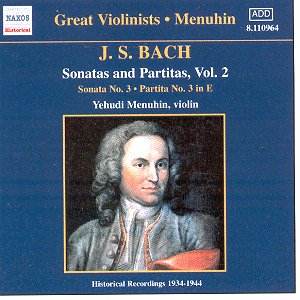J. S. BACH
Sonatas and Partitas, Vol. 2
Unaccompanied Sonata No. 3 in C major BWV 1008
Unaccompanied Partita No. 3 in E Major BWV 1006
Sonata No. 3 in E major BWV 1016 (with Hepzibah Menuhin)
Sonata No. 3 in E major BWV 1016 (with Wanda Landowska)
 Yehudi Menuhin, Hephzibah Menuhin,
Wanda Landowska.
Yehudi Menuhin, Hephzibah Menuhin,
Wanda Landowska.
Sonata no. 3: Recorded on 19th May 1934 in Paris by His Master's Voice
Partita no. 3: Recorded on 3rd February 1936 in Paris by His Master's Voice
Sonata no. 3 with Hephzibah Menuhin: Recorded on 30th March 1938 in London
by His Master's Voice
Sonata no. 3 with Wanda Landowska: Recorded on 28th December 1944 in New
York by RCA Victor
 NAXOS 8.110964
[79:06]
NAXOS 8.110964
[79:06]
Crotchet
AmazonUK
AmazonUS

This is a slightly puzzling CD. Naxos calls it, "Sonatas and Partitas Vol.
2". The conventional classical recording industry has somehow branded that
name onto the unaccompanied works for violin. There are sonatas and partitas
in this CD, but also the ones written for harpsichord and violin. This may
be misleading to the mainstream CD buyer. (Bach intended the solo violin
works to be called, "Sei Solo, a Violino senza Basso accompagnato, Libro
Primo".)
As for the solo works in this disc, I cannot help being slightly biased.
I own over twenty recordings. I have played these works and heard others
play them. These performances belong to an era before the "historical informed
performance" movement was prominent enough to mean anything to most performers.
The performances do not have the poise and grace associated with baroque
instruments and sometimes I feel that the artists' musical decisions are
slightly distasteful. However, I am sure that there are some who favour this
completely different aesthetic. I am simply not used to this approach.
The trademark Yehudi Menuhin tuning temperament on the violin is heard throughout
the CD.
This CD includes 2 versions of the same sonata; one with piano and the other
with harpsichord. I found this rather interesting. The harpsichord playing
was a little heavy in some places, but I am sure Landowska needed to play
loud against the constantly strong violin tone from Menuhin.
I would suggest listening to the harpsichord version of the E major sonata
in the morning, and the piano version at night. The sound of the piano adds
an extra element of melancholy in the slow movement adagio ma non tanto.
The sound quality is excellent, with only a slight hardly noticeable hiss
in the background.
This CD is important historically. If it were not for these musicians, we
might never have understood baroque music in the way we do today. But in
any case, Bach's music transcends all media. It sounds great on a midi keyboard
as well as on a Stradivarius violin.
Shaun Ng

